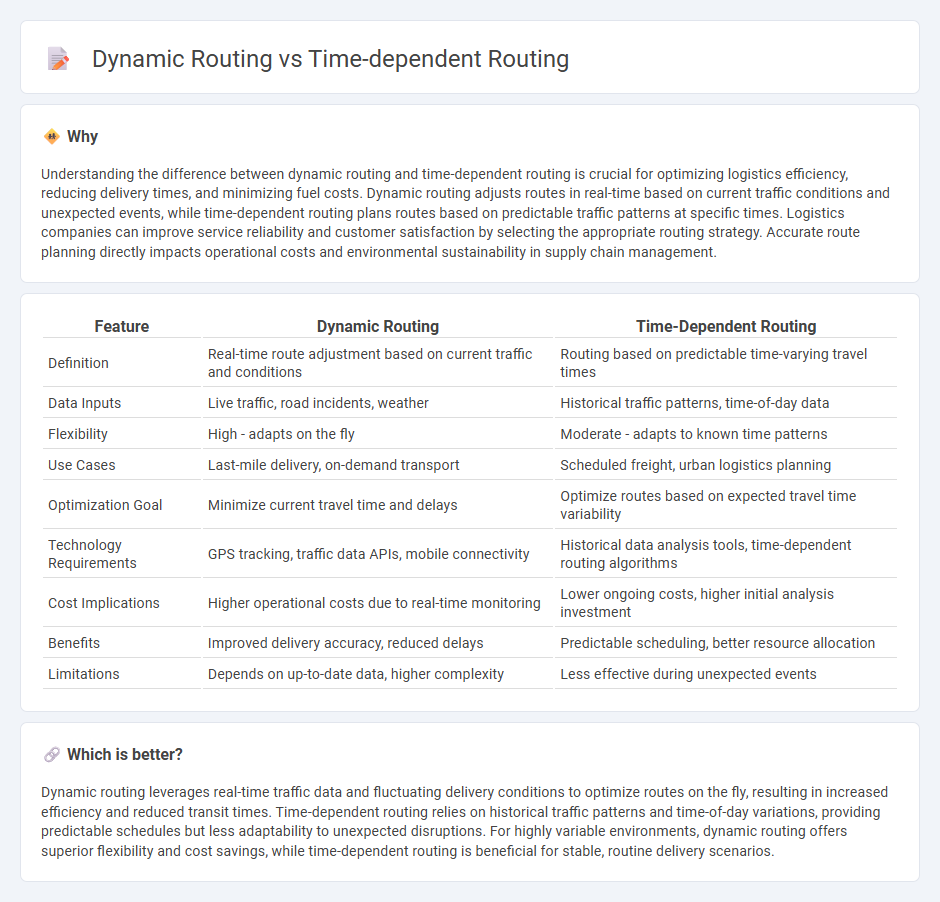
Dynamic routing uses real-time data such as traffic conditions and delivery statuses to optimize routes on the fly, enhancing efficiency and reducing delays. Time-dependent routing relies on historical traffic patterns and time-specific constraints to plan routes ahead, ensuring consistency in scheduling during predictable conditions. Explore the differences between these routing methods to optimize your logistics strategy effectively.
Why it is important
Understanding the difference between dynamic routing and time-dependent routing is crucial for optimizing logistics efficiency, reducing delivery times, and minimizing fuel costs. Dynamic routing adjusts routes in real-time based on current traffic conditions and unexpected events, while time-dependent routing plans routes based on predictable traffic patterns at specific times. Logistics companies can improve service reliability and customer satisfaction by selecting the appropriate routing strategy. Accurate route planning directly impacts operational costs and environmental sustainability in supply chain management.
Comparison Table
| Feature | Dynamic Routing | Time-Dependent Routing |
|---|---|---|
| Definition | Real-time route adjustment based on current traffic and conditions | Routing based on predictable time-varying travel times |
| Data Inputs | Live traffic, road incidents, weather | Historical traffic patterns, time-of-day data |
| Flexibility | High - adapts on the fly | Moderate - adapts to known time patterns |
| Use Cases | Last-mile delivery, on-demand transport | Scheduled freight, urban logistics planning |
| Optimization Goal | Minimize current travel time and delays | Optimize routes based on expected travel time variability |
| Technology Requirements | GPS tracking, traffic data APIs, mobile connectivity | Historical data analysis tools, time-dependent routing algorithms |
| Cost Implications | Higher operational costs due to real-time monitoring | Lower ongoing costs, higher initial analysis investment |
| Benefits | Improved delivery accuracy, reduced delays | Predictable scheduling, better resource allocation |
| Limitations | Depends on up-to-date data, higher complexity | Less effective during unexpected events |
Which is better?
Dynamic routing leverages real-time traffic data and fluctuating delivery conditions to optimize routes on the fly, resulting in increased efficiency and reduced transit times. Time-dependent routing relies on historical traffic patterns and time-of-day variations, providing predictable schedules but less adaptability to unexpected disruptions. For highly variable environments, dynamic routing offers superior flexibility and cost savings, while time-dependent routing is beneficial for stable, routine delivery scenarios.
Connection
Dynamic routing and time-dependent routing are interconnected through their focus on optimizing delivery paths based on real-time data and fluctuating traffic conditions. Dynamic routing adjusts routes in real-time by considering factors such as vehicle location and traffic congestion, while time-dependent routing incorporates time-specific variations in travel times caused by predictable patterns like rush hours. Together, these routing strategies enhance efficiency and reduce delivery delays by adapting to temporal and situational changes on the road network.
Key Terms
Time Windows
Time-dependent routing adjusts travel paths based on scheduled or predictable variations in travel times, optimizing routes according to specific time windows for deliveries or pickups. Dynamic routing responds in real-time to unexpected changes such as traffic congestion or delays, recalculating routes instantly to meet strict time window constraints. Explore more to understand how these routing strategies enhance efficiency in time-sensitive logistics.
Real-Time Traffic Data
Time-dependent routing utilizes historical traffic patterns to predict travel times based on time of day, while dynamic routing relies on real-time traffic data to adjust routes instantly according to current road conditions. Real-time traffic data integration enables dynamic routing to respond effectively to incidents, congestion, and road closures, providing more accurate and timely navigation. Explore how leveraging real-time traffic insights can optimize route planning and improve travel efficiency.
Route Optimization Algorithms
Time-dependent routing incorporates variable traffic conditions that fluctuate with time, enhancing the accuracy of route optimization algorithms by utilizing real-time and historical traffic data. Dynamic routing adapts swiftly to current network states and unexpected changes, such as accidents or road closures, offering flexible route recalculations to optimize travel times. Explore advanced route optimization algorithms to understand how these routing strategies improve efficiency in modern navigation systems.
Source and External Links
Arc Routing with Time-Dependent Travel Times and Paths - arXiv - Defines the time-dependent capacitated arc routing problem (TDCARP), where travel and service speeds vary over time on the network, presenting algorithms and heuristic methods to optimize routing when quickest paths change dynamically.
Time Dependent Vehicle Routing Problems: Formulations, Properties and Heuristic Algorithms - Discusses formulations and heuristic algorithms for the time dependent vehicle routing problem (TDVRP), where travel times vary with time of day and the route optimization aims to minimize total travel time while serving customers with fixed demands and time windows.
Time-dependent routing - Provides an overview of the field of time-dependent routing, which involves designing optimal routes in graphs where arc traversal times vary over time, discussing travel time modeling, applications, and solution methods developed in recent years.
 dowidth.com
dowidth.com